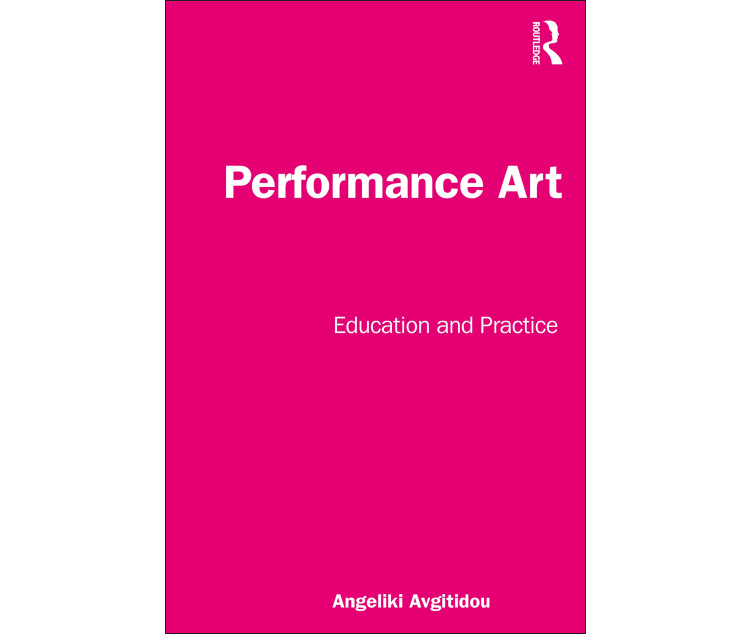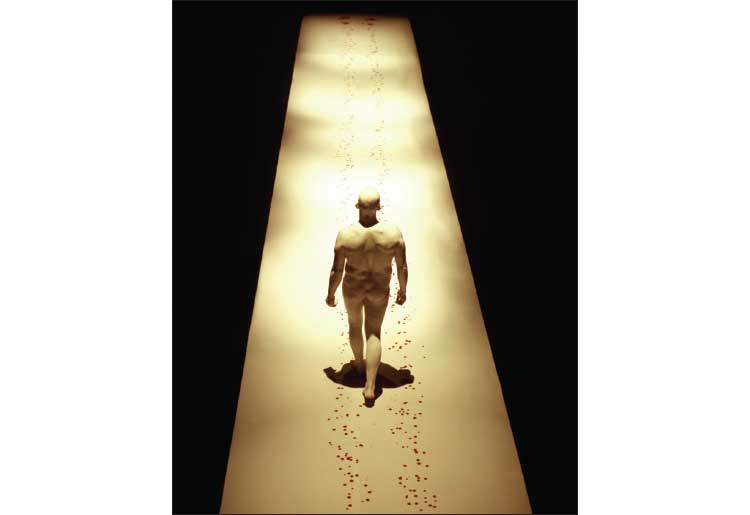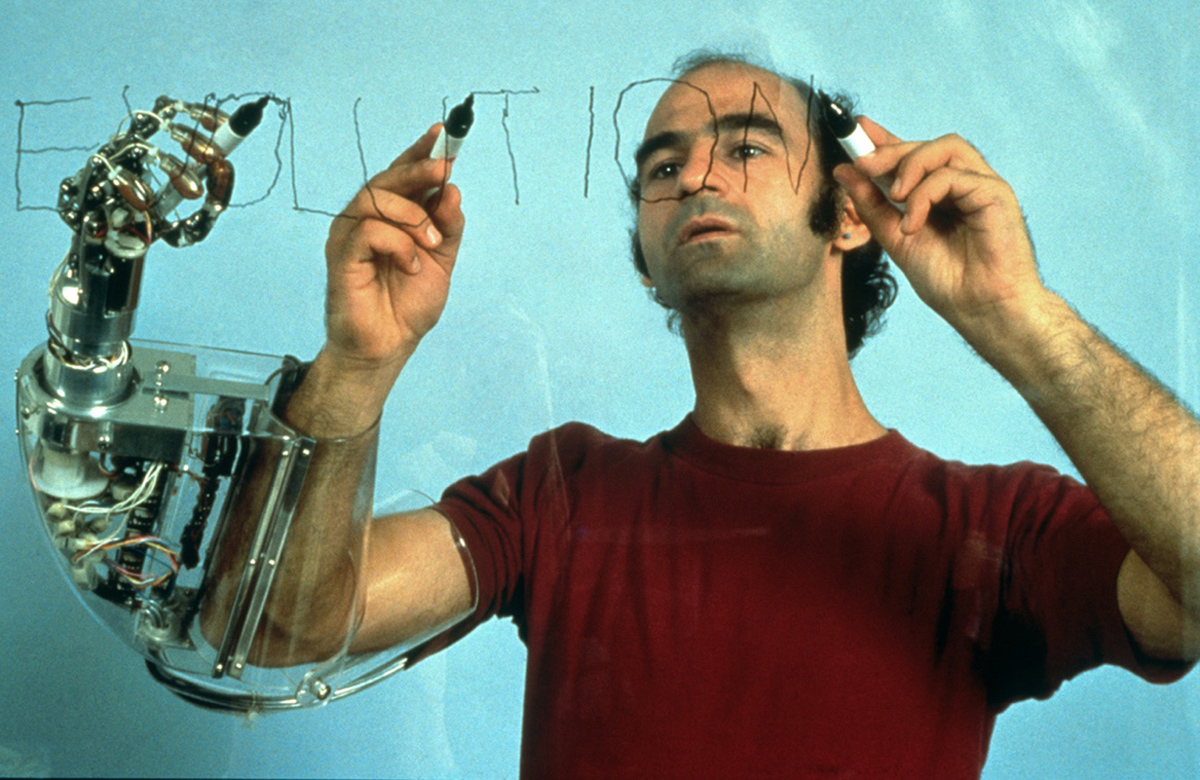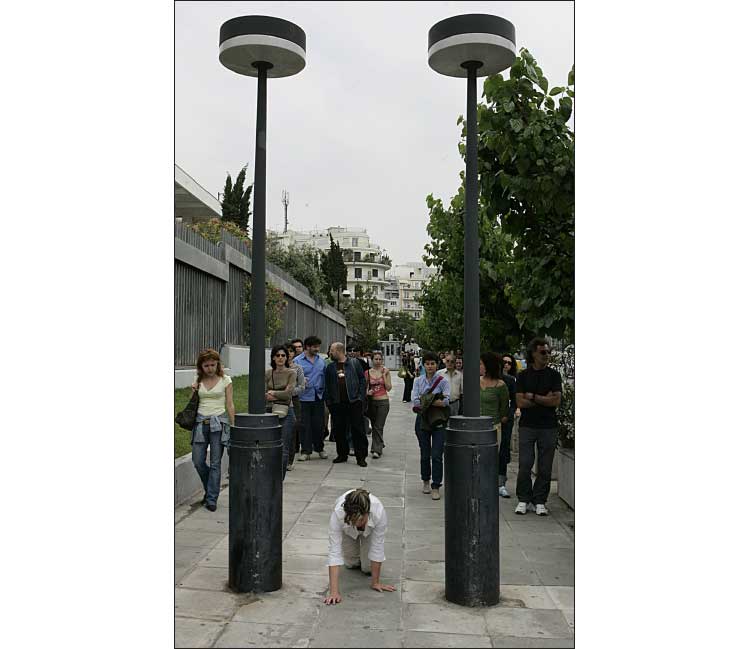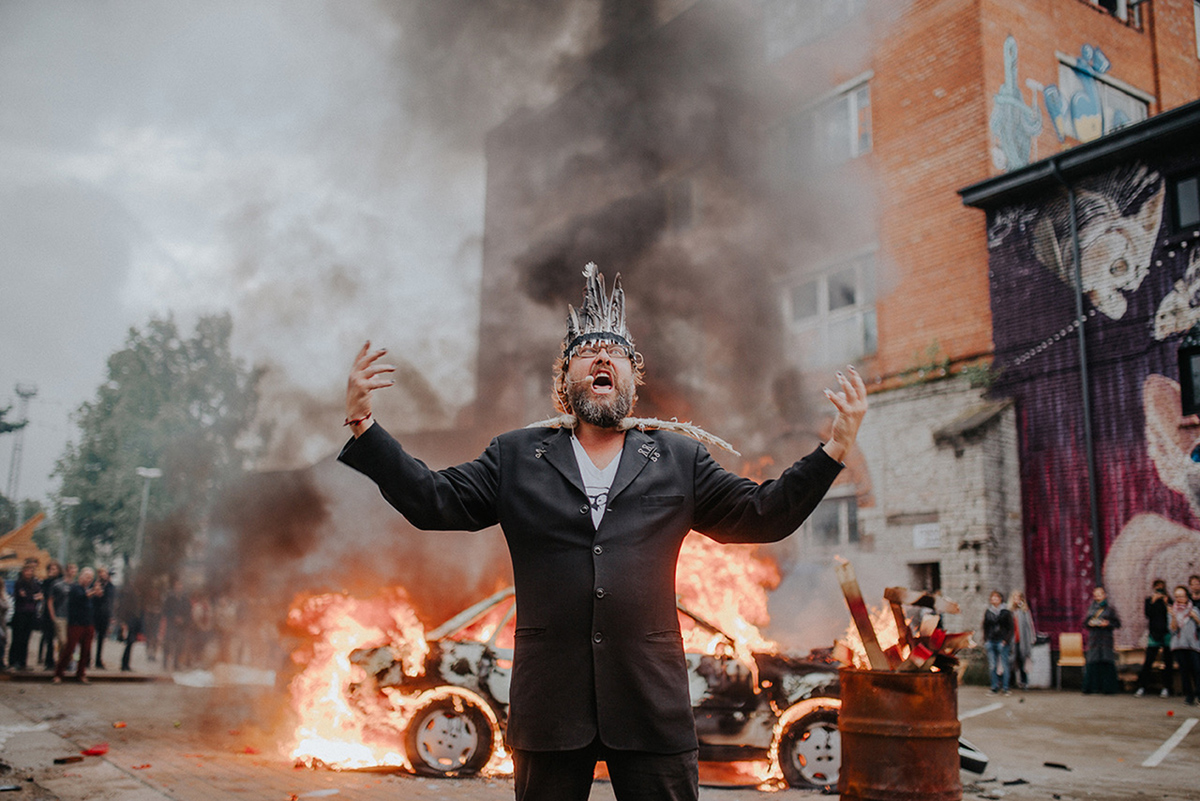Performance Art: Education and Practice. Book Cover by Publisher: Routledge; 1st edition (30 Mar. 2023). Language: English.
Introduction
Angeliki Avgitidou is an artist working in performance and public space. She studied as an architect (BArch Hons, Aristotle University of Thessaloniki) and an artist (MA, PhD, Central Saint Martins College of Art and Design). Her work has been shown in occasions that include the Thessaloniki Biennale of Contemporary Art, its Performance Festival, the International Biennial of Performance Deformes, the Prague Quadrennial of Performance Design and Space and the 15th International Exhibition of Architecture of the Biennale of Venice. Avgitidou is also Associate Professor at the School of Fine Arts of the University of Western Macedonia where she has taught postgraduate courses in the same university, the Hellenic Open University and the Transart Institute. Avgitidou is author of the former book Performance Art: The Basics. A beginner’s Course Guide (University Studio Press, 2020). This book, Performance Art: Education and Practice (2023), builds on this previous volume, extending concerns with the fundamental elements of performance, body, space, objects to now include the radical, augmented, ecological, reflecting on performances of artists being together with non-human agents as a means of unearthing, critically questioning, and ethically challenging hegemonic norms.
It is important to note that this book has been published in 2023, a period of global turmoil, post Brexit, post the intensities of the COVID pandemic, but where we find ourselves in a state of climate emergency and amongst world politicians who could be considered themselves as post-truth performers. It is also a period when funding and support of the Arts and arts in education, is under attack. In the UK, our own Live Art Development Agency (LADA) has gone through various significant upheavals over the last few years and only this month Sept 2023, has re-entered the Arts Council NPO pool along with its new board of directors. However, what all this signals, never more so, is the need to uphold and support the structures of performance art. Valuing the personal, subjective and performative as means to advocate for, teach and extend the tools of performance in celebration. This book does that by illuminating multiple ways of raising awareness and transforming communities and lives through performance.
Performance Art: Education and Practice is intent on introducing students of fine and performing arts to his/her/queer/stories of the discipline. Through practical provocations, embodied enactments and reflective activities; scholars, teachers and artists alike can find something experientially useful within its pages. It provides a comprehensive tool kit of exercises, intended to activate experimentation and generate deep somatic understandings of the material. Through encouraging the testing of concepts and ‘theories-in action’, (Bell, 2021:80) through practice, the main seminal and germinal legacies of performance art, are interrogated. Through acts of bodily, augmented, everyday, spatial and archive re/enactment, held within Avgitidou’s accessible framing, artists new to performance art, will gain the tools to personally contribute to a powerful legacy of rebellious, courageous and radical performance making.
The author was motivated to write this volume because of her own experience as a pedagogist and practitioner of performance art and her perceived need for a book that could interconnect central developments in performance art, with its broader his/her/queer/stories and practical skills. She acknowledges in her endeavour theoretical indebtedness to the mainly western discourse of Rose Lee Goldberg, Richard Schechner and Marvin Carlson. However, Avgitidou’s focus is instead weighted towards the methodological tools of teaching the practice of performance art, rather than debating its theoretical or (his)torical canon. Indeed, Avgitidou centres her approaches herein, more on practitioner volumes, such as those produced by La Pocha Nostra, Valentin Torrens, Joshua Sofaer, Leslie Hill, Helen Paris and John Britton. All authors she cites as inspirational in their output of curious ‘how to’ guides. Because this book review is made within the scope of this Body, Space, Technology journal, I will focus on the content found in several of the main chapters most pertinent to BST readers. However, the case studies in all chapters are designed to encourage the reader towards further artistic research and to incite performance making. Case studies include both well-known and lesser-known performers and are connected thematically rather than chronologically. The author starts each chapter by providing some introductory contexts, designed to entice the reader into wider topic areas, offering optional lines of enquiry to pursue elsewhere. In this sense, the book doesn’t aim to present an in-depth study of performance art as such, but it is a well-structured, easy to read overview, and provides many available tools, exercises and reflections to follow chronologically or dip into thematically. Much like Hans Ulrich Obrist’s ‘do it’ compendium (2013), it presents easily accessible practice prompts which can be reinterpreted and re-enacted multiple times as varying points of departure, but it does so from an educator’s perspective, rather than as in ‘do it’, from the artists standpoint. Indeed, this mechanism signposts towards a potential third volume by Avgitidou that might next seek to share student’s perspectives on their application of such prompts and the usefulness of these.
Body, Gender, Identity
The body as a performative expression of gender and identity is central to chapter 3. The author first takes us through the feminist waves of radical, social and liberal feminism on into discussions of inequality, subjective experience, Marxism, colonialism and psychoanalysis. These are made via Simone de Beauvoir, Angela Davis, Andre Lorde, Silvia Federici and Luce Irigaray. She then exposes key practitioner actions, as found in the Guerrilla Girls, and Womanhouse, against questions of objectification and the male gaze in relation to Laura Mulvey’s concerns. Avgitidou next introduces performative notions of gender and queer theory through Judith Butler and demonstrates how gender binaries are destabilised in favour of fluidity. She also opens some discussion on associated new research methodologies, wherein the artist is both performer and bodily subject. The focus, to enable readers to recognise, deconstruct and actively reconstruct, identities of the body through practical and reflective activities.
Also, in this chapter artists such as Valie Export; Shigeko Kubota; Carolee Schneemann; Ana Mendieta; Wangechi Mutu; Gina Pane; Ron Athey; Angelika Fojtuch and Franko B are featured as a means of providing context to her enquiry. Each artist has a featured work, followed by reflective questions. Although the artists referenced are predominantly well known and western-European (with a few exceptions), the provocations are often brave. Considerations such as how a performance artist organises their relationship to viewers; acts of intimacy; personal disclosures, and what impact that has on spectators/participants in terms of risk and benefit. Also, how aesthetics, staging, symbology and scenography invite audience engagement. She also asks her reader to consider, how the body can be used as a site and carrier of actions and messages and what the role of performance documentation or lack of capture has on the message being conveyed.
This image from Franko B’s I Miss You, starts to bring chapter 3 to a conclusion. It embodies concerns with spectatorship; pain as a means of enhancing artists presence and the absenting of symbols and signs. Avgitidou describes Franko’s tattoos, hidden under his white-painted over body, as ‘more naked than nakedness itself’, (Avgitidou, 69: 2023). Indeed, her commentary on Franko’s blood-spotted catwalk, is that of the exposed, vulnerable and naked state of us all in our present, fragile and conflicted society. At the end of this chapter, she gives two practice prompts to aid the reader in a creation of a two-person performance and her reflections start to draw comparisons between different practitioner approaches and spaces of the in-between. However, one activity is very simple, the other highly provocative and the latter calls for a much greater context in terms of ethics. Indeed, educators leading such an activity would need to ensure the creation and maintenance of a safe container for any students wishing to experiment with such approaches, which address reflections on violence in the everyday. Perhaps this points to a fourth volume on ethical and safe performance art, education and practice. Indeed, although a broad introduction to body, gender and identity is made, a greater emphasis on the queered body would be a welcome future extension to her writing.
The Augmented Body
The author begins with a solid introduction to what it means to be more-than human, with a clear intention to decentre our perceptions of otherness, including considerations of ethics; augmentation; the alien and imagined and the lost and desired. Theoretical inroads are made into concepts such as transhumanism and its technological and scientific concerns via Francesca Ferrando, 2023. Posthumanism is also foregrounded via Donna Harraway (2015 [1991]), as we begin to understand what it is to decentre the human by entwining with other species in a post-gender, post-body, cyborg world. Avgitidou furthers her discussion via Rosi Braidotti (2016) and talks of entities that might morph to offer new egalitarian and connective agencies cross-species, untethered and hybrid. Indeed, she works towards a reader understanding of what Aloi and McHugh (2021) termed as a state of ‘post-identity’. In doing so she advocates how we might use augmented performances to provoke conceptual and political change, by generating new ontologies as a means of opening new taxonomies and ecologies on the ‘identity and the politics of survival’, (Avgitidou, 2023: 25).
In this complex chapter 5, Avgitidou carefully separates it into two clear sections on body extensions and body modifications for ease of readership. Regarding bodily extensions, she takes us through a journey via artists Rebecca Horn, Lisa Bufano, and Mari Katayama. Horn is an obvious point of departure and successfully provides opportunity for students to dive straight into action, rather than reflection, through simple bodily and sculptural extensions activities. Such provocations next gain complexity, with suggestions of greater restriction and bodily alteration through haptic, visual and other visceral combinations. We then move into the intermedial through Narcissister’s (2010) work IN*TANDEM wherein notions of race, beauty, class and gender are encountered through inorganic-organic, monstrosities (Lucian Gomoll, 2011), and masked identities. Similarly, our invitation to understand Katayama’s (2016) self-referential photographic and sculptural patchwork portraits, allow us to imagine into her experience of being an amputee, challenging normative body assumptions through awareness of her staged extensions.
As the discussion moves to the modified body, the author starts to discuss the uncanny, succinctly describing how after Freud (1919) this notion combines something of the familiar with the strange, often triggering repulsion, fear or horror in the viewer. This leads Avgitidou to Stelarc and description of his seminal hybrid bodily incorporation of man and machine in Third Hand – Handswriting (1982).
Stelarc, Third Hand – Handswriting, Writing one word simultaneously with three hands, Maki Gallery, Tokyo, 1982. Photographer: Keisuke Oki. Courtesy of the artist.
In this work Stelarc, was considered to pioneer the beginnings of an intermingling of art and science within the performance arts field, utilising electrical impulses from his body to activate a third mechanical hand to draw with him. This idea of a semi-permanent body extension he developed further in ‘Ear on Arm’ (2006), wherein a third ear was grafted surgically onto his arm. Both these projects are part of Stelarc’s continued exploration into intimate technological and prosthetic interfaces that raise further questions on bioscience, interconnectivity and the ethical question of what is ‘the body’ as opposed to ‘the self’. Less extreme and more easily replicable augmentations are next introduced through the works of Paddy Hartley and Lucy McRae, with associated practice activities. This is followed by further multi-sensory provocations in relation to Peter de Cupere’s practice, appropriately contextualised within a post-pandemic climate and further considerations regarding bodily excretion.
The author starts to conclude chapter 5 with a case study on the surgical operating room and the performance apparatuses of Orlan, before situating further discussion within the realm of the wearable. Aided by Sita Popat et al. (2017) wider realms of medicalised performance and ubiquitous digital devices are bought into play, that both enable and restrict performative expressions. Avgitidou, concludes by touching on data collection, visualisation and adornments but only in passing. However, as a chapter, the author has successfully opened imaginative opportunities for students to envision further new forms of hybrid bodies and a more inclusive approach to performing inter-species.
Body and Space & Performing in Public Space
As reviewer of this book, I am curious that the author comes from an original background in architectural training, and taken from this perspective, I perceive she has applied a more objective practical scaffold to her volume, through which to interrogate the inner conceptual workings of the performance artists studied. In relation to my own research, this embodies a form of what I came to term a ‘feeling architecture’ (Bell, 2021: 36), fostering both an educational and practice experience. Body and Space chapter 6, focuses on the phenomenology of inside spaces, both the inner world of the performer and the outer structures of site, its geometry, function and inhabitants. Avgitidou draws upon Gaston Bachelard, Doreen Massey, Elizabeth Grosz and Henri Bergson in conversations on site-specific and site-responsive performance. I am not going to dwell on this chapter, which is much more self-explanatory and includes exercises and reflections on artists such as Bruce Nauman and Nam June Paik, in terms of usefully exploring lines, limits and the borders of space. It also references Bruce McLean, Paul Harrison, John Wood and Manolis Lliakis in terms of the creation of micro-environments. Further confrontations with space are found through Dannis Oppenheim, Janez Jansa, Kira O’Reilly and Jennifer Willet. The chapter then concludes with activities on the works of Janine Antoni, Dan Graham and Vito Acconchi in consideration of body, space, audience; the furniture of spaces; invitations to occupy, disrupt depart, or dwell durationally. Similarly, the public sphere is interrogated in terms of the social fabric of conflicting exchanges between people, places and institutions, safety, public good, exclusion, ownership, and control. Concepts of the flaneur, the Situationalists and psychogeography are also bought alive through studies of artists Sophie Calle, Alicia Framis, Francis Alys, and Evangelia Basdekis.
In the image below, Figure 4, we see Basdekis, crawling through Athens towards the National Museum of Modern Art, wherein she then pauses for 20-mins, kneeling in devotional prayer, drawing attention to the social status of the artist in society, seeking acceptance into the institution of art. Avgitidou next makes a very useful juxtaposition to the same performance but conducted in a different setting, Bristol in England, which due to its change of site and audience, instead incited insult and a very different reading on Basdekis positioning on all fours, as alternatively sexual. This helpfully leads the reader to consider site-specificity and ordinary acts in different contexts, conflicting reactions, lawfulness, social and political agency. Although there isn’t space to review this whole chapter in full, it is strong for its depth, diversity and easy accessibility, all held within the authors knowledgeable framing of the theme.
Performing Radical Interventions
I will conclude this book review with a focus on chapter 9, radical interventions. This section is centred on process-based art and provides an overview of political and activist art, in part related to theorist Lucy Lippard’s (1997) theories of co-authorship. Avgitidou makes general distinctions between the interrelated practices of participatory, community and socially engaged art and explores some of the contested terms and arguments associate with these practices. As a reader we learn of Nicolas Bourriaud on relational aesthetics, human relations and social contexts; Claire Bishop on participatory art and aesthetics, and Miwon Kwon on homogenisation within community-art constructs that obscure difference. The author critically aligns some of these concerns to case studies on artists Willi Dorner, Krzysztof Wodiczko, and Lucy Orta and their various playful, poetic, nomadic and temporary responses, bringing a performative commentary to serious humanitarian crises, refugee, ecological and other political concerns. Avgitidou also draws attention to the use of artist personas as a form of radical cheerleading (in Avgitidou 2023: 175) to rethink space, capital and media manipulation. In the latter case studies, the focus is instead on how to orchestrate participation through cultivating transitory community actions and momentary interventions, as illustrated by the works of artists Suzanne Lacy and Thomas Hirschorn. This then shifts a gear to the study of impromptu protest interventions, performances bordering on anarchism, and with an anti-systemic agenda. Whilst important, this aspect is less accessible to the wider audience to which this book is aimed and not as replicable experientially within an educational setting. More useful however is the concluding section on how radical performance has been applied within education. Here Tania Bruguera’s free art school formation of ‘artivism’, which advocates the use of art to transform social injustice and empower human rights is more digestible. Indeed, the authors reference to La Postra Nostra, a group she has worked with, describes his performance pedagogy as a ‘temporary space of utopian possibilities, highly politicised, anti-authoritarian, interdisciplinary, (preferably) multi-racial, poly-gendered and cross-generational and ultimately safe for participants to really experiment’ (Gomez-Pena, Guillermo & Sifuentes, Roberto 2011: 3). In conclusion, I think this remark, also fits with the intentions of the author in writing this curiosity guide to doing performance art in education. Certainly, I am going to end this review with the Non-Grata group. In 1998, they formed Academia Non Grata, a non-hierarchical performing arts academy, founded in newly emancipated Estonia, freed from Soviet Union rule in 1991. Not that it is easy to generate (from a Western perspective) a situated performance in response to this experience, at the time of writing, it is important to draw attention to their activities, most significantly at a time when Russia has invaded Ukraine, with intent to occupy and rule, since February 2022.
Here we see in Figure 5, one of Non-Grata’s academy members in a safe reconstruction of a very real experience. Using tools akin to circus, low-tech, makeshift, rebellious, and primitive, but vital. Their anti-establishment and non-hierarchal performance methods ensure teachers and students alike, live, think, and make together, a ‘school of life conduct and survival rather than a traditional art school’, (Avgitidou, 2023:185). So, I will end this review with a final provocation, in that perhaps the future of performance art and education lies within these very practices, wherein deep relational encounters (Bell, 2022), intermingle across species and borders, activating new forms of performance pedagogies, ecologies and opportunities for hybrid and humanitarian change.
Competing Interests
The author has no competing interests to declare.
Author Information
Dr. Alice Bell is Acting Deputy Head of the School of Creative Arts, Deputy University Tutor and Programme Leader, Fine Art at the University of Lincoln. Alice studied at Goldsmiths, before attaining a BA Hons Fine Art, First Class, from The Slade School of Art; an MA in Creative Technologies, Distinction, and a PhD in Enabling Deep Relational Encounter Through Participatory Practice-Based Research (Part-Pb). As an artist, Alice works in a multimodal and participatory manner, interpreting deeply idiographic and dialogic materials through text, performance, sound, video, and interactive technologies. She integrates skills gained from other postgraduate certificates held in Integrative Arts Psychotherapy and Psychosynthesis Coaching, in the pursuit of generating new relational pedagogies. Through a synthesis of theory and practice, she applies in-action, concerns of the interpersonal, psycho-social and maternal within all her roles; professional, educational and artistic. These approaches she filters through and contextualises within contemporary art debate, in pursuit of transforming lives and communities through participatory practice-based research.
https://staff.lincoln.ac.uk/39546fa1-5bca-4b71-8900-145b06303cb5
ORCID 0000-0001-8473-5220
References
Books
Avgitidou, Angeliki. (2020). Performance Art: The Basics. A beginner’s Course Guide. Greece: University Studio Press.
Avgitidou, Angeliki. (2023). Performance Art: Education and Practice. London and New York. Routledge. DOI: http://doi.org/10.4324/9781003197904
Bachelard, Gaston. (1982). The Poetics of Space, M. Jolas (Trans.). Boston: Beacon Press.
Bergson, Henri. (1995). Memoria Y Yida. Spain: Altaya Press.
Britton, John. (2022). How to Teach Performance. Torrazza: Amazon.
Butler, Judith. (1999 [1990]). Gender Trouble: Feminism and the Subversion of Identity. London and New York. Routledge.
Carlson, Marvin. (2017 [1996]). Performance: A Critical Introduction. London and New York. Routledge.
Davis, Angela. (1981). Women, Race and Class. London: The Womens Press.
De Beauvoir, Simone. (2010 [1949]). The Second Sex, C. Borde & S. Malovany-Chevallier (trans.). New York: Vintage.
Federici, Silvia. (2012). Revolution at Point Zero: Housework, Reproduction, and Feminist Struggle. New York: PM Press.
Goldberg, Rose Lee. (1988). Performance Art: from Futurism to the Present. London: Thames and Hudson. DOI: http://doi.org/10.2307/1578724
Gomez-Pena, Guillermo & Sifuentes, Roberto. (2011). Exercise for Rebel Artists: Radical Performance Pedagogy. London and New York. Routledge.
Grosz, Elizabeth. (1995). Space, Time, and Perversion: Essays on the Politics of Bodies. London and New York. Routledge.
Harraway, Donna. (2015 [1991]). Simians, Cyborgs, and Women: The Reinvention of Nature. London and New York. Routledge.
Hill, Leslie & Paris, Helen. (2012). Curious Methods. Bristol: Intellect.
Irigaray, Luce. (1991). The Irigaray Reader, M. Whitford (Ed.). Cambridge, MA: Basil Blackwell.
Lippard, Lucy. (1997). Six Years: The Dematerialization of the Art Object from 1966 to 1972. California: University of California Press.
Lorde, Andre. (2018). The Master’s Tools Will Never Dismantle the Master’s House. Penguin Classics.
Massey, Doreen. (2014). Space, Place and Gender. Minneapolis: University of Minnesota Press.
Mulvey, Laura. (1975). Visual and Other Pleasures. New York: Palgrave.
Obrist, Hans Ulrich. (2013). do it compendium. New York: Distributed Art Publishers.
Schechner, Richard. (2004 [1998]). Performance Theory. London and New York: Routledge. DOI: http://doi.org/10.4324/9780203426630
Sofaer, Joshua. (2009). The Many Headed Monster. London: Live Art Development Agency.
Torrens, Valentin. (2014). How we teach Performance art: University Courses and Workshop Syllabus. Parker, CO: Outskirts Press.
Book Chapters
Bell, Alice. (2022). A New Framework for Enabling Deep Relational Encounter Through Participatory Practice-Based Research. In Vear, Craig; Candy, Linda; Edmonds, Ernest (Eds.), The Routledge International Handbook of Practice Based-Research (pp. 607–614). Routledge: London. DOI: http://doi.org/10.4324/9780429324154-45
Journals
Aloi, Giovanni & McHugh, Susan. (2021). Introduction: Envisioning posthumanism. In G. Aloi & S. McHugh (Eds.), Posthumanism in Art and Science: A Reader (pp. 1–21). New York: Columbia University Press.
Braidotti, Rosi. (2016). Posthumanist feminist theory. In L. J. Disch & M. E. Hawkesworth (Eds.), The Oxford handbook of feminist theory (pp. 673–98). Oxford: Oxford University Press. DOI: http://doi.org/10.1093/oxfordhb/9780199328581.013.35
Ferrando, Francesca. (2023). Posthumanism, Transhumanism, Antihumanism, Metathuanism and New Materialisms: Differences and Relations. Existenz: An International journal in Philosophy, religion, Politics and the Arts, 8(2), 26–32.
Gomoll, Lucian. (2011). Posthuman performance: A feminist intervention. Total Art Journal, 1(1), 2–15.
Popat, Sita, et al. (2017). Bodily extensions and performance. International Journal of Performance Arts and Digital Media, 13(2), pp. 101–4. DOI: http://doi.org/10.1080/14794713.2017.1358525
Websites
Arts Council England. (2023). NPO Homepage. Available at https://www.artscouncil.org.uk/NationalPortfolio23 [Last accessed 29 October 2023].
Live Art Development Agency (LADA). (2023). Homepage. Available at https://www.thisisliveart.co.uk [Last accessed 29 October 2023].
Theses and Dissertations
Bell, Alice. (2021). Digital Performance. The Angel of Art Sees the Future Even When She Flies Backwards: Enabling Deep Relational Encounter Through Participatory Practice-Based Research. Unpublished thesis (PhD), De Montfort University. DOI: http://doi.org/10.4324/9780429324154-45
